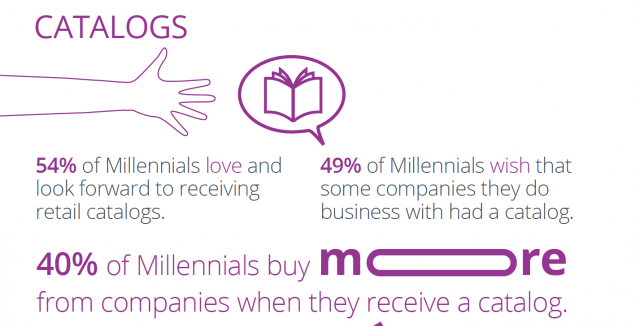For brands that use social media and other online sales funnels, the actual products or services they are promoting is just the tip of the iceberg, according to Sarah S writing for Hansel Group Marketing.
“What you’re actually day-trading on is attention — namely, your consumer’s attention. And it’s more than just mere novelty that captures your customers’ attention,” she writes. “As we’ll see, it takes a unique blend of creativity, personalization and quality — features that are also key to the effectiveness of the print catalog.”
The article notes some important facts – not conjecture, but honest to goodness facts – about catalogs:
- catalogs drive online buying: 70% of shoppers agree that a quality catalog triggers online purchases and coaxes consumers to remain browsing on the site longer
- catalogs increase brand awareness: 86% of those who received catalogs are more likely to keep it displayed on a coffee table or shelf
- catalogs contribute to the increase in sales: E-commerce companies choosing to integrate both print and digital experience 50% of their targeted audience purchasing more over time
- customers still prefer physical experiences: 63% of consumers surveyed mention that they find it easier and more pleasurable to browse products in today’s highly-editorial and quality print catalogs rather than online or even in-store
We’ve shared a lot of these facts before, so it’s no surprise we see digital brands like eBay and Amazon launching print catalogs. Customers love them, especially the important Millennial demographic.

Source: Quad/Graphics Customer Focus 2014
The beauty of modern catalogs lies in how effective they are in telling the story around those products you’re selling.
“When you log on to an e-commerce site, it’s easy to see that product listings are functional. They’re poised to provide transparency and visibility while descriptions are intended to tell a story about its use,” Sarah continues. “Here, it’s product first, story optional.
“Print catalogs give brands the chance to flip that script: With the printed medium, it becomes, story first, product second,” she continues.
So forget what you may think about catalogs and the modern consumer; according to CNBC, millennials are more interested in catalogs than your grandmother is. (And our grandmothers liked catalogs … a lot.) The return on investment is solid, especially among a brand’s top customers.
Bonobos, eBay, Wayfair, Amazon, Ikea, and countless smaller brands are all-embracing catalogs in the digital age. Because life without catalogs would mean brands continue to fight for air in the increasingly suffocating online space.
Do digital brands need catalogs to sell stuff? I don’t think there’s any doubt about it.

January 16, 2020, 7:17 pm
February 3, 2020, 1:36 pm